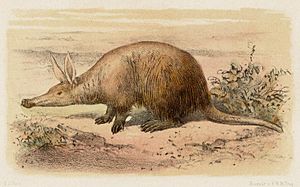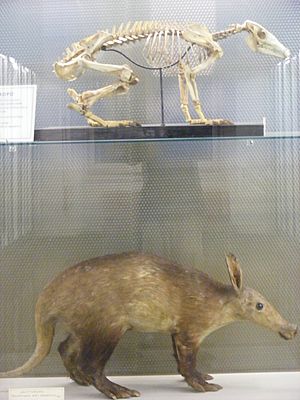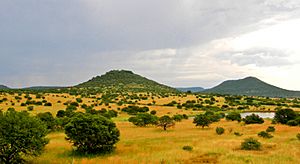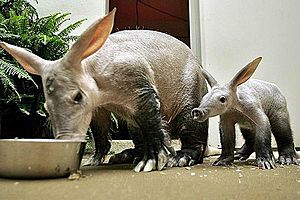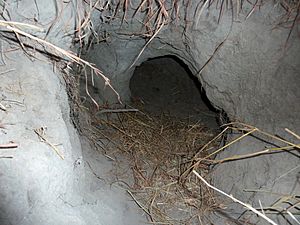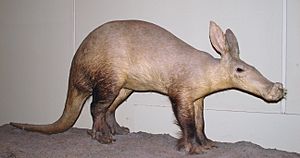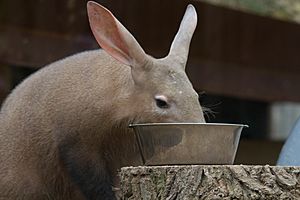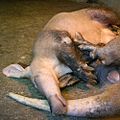Aardvark facts for kids
Quick facts for kids AardvarkTemporal range: Pliocene–Recent
|
|
|---|---|
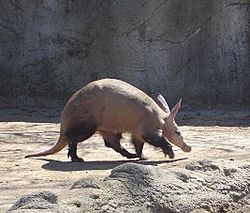 |
|
| Scientific classification | |
| Kingdom: | |
| Class: | |
| Superorder: | |
| Order: |
Tubulidentata
|
| Family: |
Orycteropodidae
|
| Genus: |
Orycteropus
|
| Binomial name | |
| Orycteropus afer |
|
 |
|
| Aardvark range map | |
The Aardvark (Orycteropus afer) is a unique mammal that lives in Africa. Its name comes from the Afrikaans language and means "earth pig". This is because aardvarks are excellent at digging burrows! It's the only living animal in its special group, or order, though some ancient relatives have been found as fossils.
Contents
What's in a Name?
People sometimes call the aardvark the "African antbear" or "Cape anteater". The name "aardvark" comes from the word erdvark in early Afrikaans. It means "earth pig" or "ground pig". This name fits perfectly because aardvarks love to dig in the ground.
Aardvark Family Tree
The aardvark's closest living relatives are surprising! They include elephant shrews, hyraxes, tenrecs, and even elephants. They also share a family with sirenians, which are animals like manatees.
Scientists have found fossils of aardvarks that are 5 million years old. These ancient relatives lived in places like Europe and Asia. A close cousin of the aardvark also lived on the island of Madagascar during the last ice age.
Aardvark Appearance
Aardvarks look a bit like pigs, but they are very unique. Their bodies are strong with a curved back. They have a few coarse hairs covering their skin. Their legs are not too long, and their front feet have four toes. Their back feet have all five toes.
Each toe has a large, strong nail. These nails are flat and shaped like shovels. They are perfect for digging!
Head and Snout
The aardvark has long ears and a very thick tail that gets thinner towards the end. Its head is long and sits on a short, thick neck. The end of its snout is round like a disc, and that's where its nostrils are. This snout looks a lot like a pig's nose.
The aardvark's mouth is small and shaped like a tube. This is common for animals that eat ants and termites. They have a long, thin, tongue that can stretch out about 30 centimetres (12 in). Aardvarks also have an amazing sense of smell.
Aardvarks usually weigh between 40 and 65 kilograms (88–143 lb). They are about 1 and 1.3 metres (3.3–4.3 ft) long. If you include their tail, which can be up to 70 centimetres (28 in) long, they can reach 2.2 metres (7 ft 3 in) in total length.
Their color is usually pale yellowish-gray. Often, their skin looks reddish-brown from the soil they dig in. Aardvarks have a thin coat of hair. Their tough skin is their main protection. They sometimes sleep in old ant nests, which also keeps them safe from predators.
Where Aardvarks Live
Aardvarks live in sub-Saharan Africa. This means they are found in the parts of Africa south of the Sahara Desert. They need places with good habitats and plenty of food. They live in savannas, grasslands, woodlands, and bushland. These areas have lots of ants and termites for them to eat.
The only major habitat they don't live in is swamp forests. Aardvarks have been seen as high as 3,200 metres (10,500 ft) in Ethiopia. They are found across most of sub-Saharan Africa, all the way down to South Africa.
Aardvark Life and Habits
Aardvarks are nocturnal, meaning they are active at night. They are also solitary animals, meaning they usually live alone. Their diet is mostly ants and termites. The only fruit they are known to eat is the aardvark cucumber.
An aardvark comes out of its burrow in the late afternoon or after sunset. It then searches for food over a large area, sometimes 10 to 30 kilometers wide. It swings its long nose from side to side to sniff out food. When it finds a group of ants or termites, the aardvark starts digging. It uses its powerful front legs to dig quickly. Its long ears stay upright to listen for any predators.
An aardvark can dig 2 feet (about 60 cm) in just 15 seconds! While digging, it moves fairly slowly. Its strong claws help it dig through the very hard crust of termite or ant mounds. It seals its nostrils to keep dust out. Once it reaches the insects, the aardvark uses its long tongue to lick them up. The tough skin protects it from the ants' stings or termites' bites. Its excellent hearing helps it hear lions, leopards, hyenas, and pythons.
Home Sweet Burrow
Besides digging for food, aardvarks also dig burrows to live in. They have temporary burrows scattered around their home area for quick safety. They also have a main burrow where they raise their young. These main burrows can be very deep and long. They can have several entrances and be as long as 13 metres (43 ft). Some are even big enough for a person to enter!
Aardvarks often change the layout of their main burrow. Sometimes, they move and dig a completely new one. Their old burrows are then used by smaller animals, like the African wild dog.
Only mothers and their young share burrows. However, aardvarks are known to live in small family groups or alone. If an aardvark is attacked in its tunnel, it will dig out of the tunnel. This puts fresh dirt between it and the predator. If it decides to fight, it will roll onto its back and attack with its claws.
Aardvark Babies
Aardvarks only pair up during the breeding season. After about seven months, one cub is born, usually between May and July. The cub weighs around 2 kilograms (4.4 lb). After only two weeks, the cub can leave the burrow with its mother. It starts eating termites at 14 weeks old and stops drinking milk at 16 weeks. By six months old, the cub can dig its own burrows. However, it often stays with its mother until the next mating season.
Aardvarks can live for up to 24 years in captivity.
The main predators of aardvarks are lions, leopards, hunting dogs, and pythons. Some African tribes also hunt aardvarks for their meat. Aardvarks can dig very fast or run in a zigzag pattern to escape enemies. If that doesn't work, they will fight back with their claws, tail, and shoulders. They might even flip onto their backs to hit with all four feet. Their thick skin also gives them some protection.
Aardvark Conservation
It was once thought that aardvark numbers were going down. However, this was likely because they are hard to spot due to their secretive nature. There are no exact counts of aardvarks. But their numbers seem to be stable overall. There might be a small decrease in eastern, northern, and western Africa.
However, in Southern Africa, their numbers are not decreasing. The IUCN (International Union for Conservation of Nature) lists the aardvark as "least concern". This means they are not currently in danger of extinction.
Aardvarks in Stories
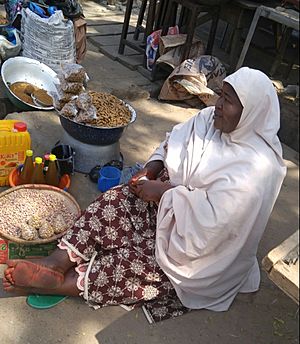
In African folklore, people admire the aardvark. They respect its hard work in finding food. They also admire its brave response to soldier ants. Hausa magicians sometimes make a special charm. They use the heart, skin, forehead, and nails of an aardvark. They pound these parts with the root of a certain tree. This charm is wrapped in a piece of skin and worn on the chest. People believe it gives the owner the power to pass through walls or roofs at night. This charm is said to be used by burglars. Also, some tribes use aardvark teeth to make bracelets. These bracelets are thought to bring good luck.
Some people believe the Egyptian god Set has the head of an aardvark. Or they think he is partly an aardvark.
The main character of the TV show Arthur is an aardvark. This animated children's show is based on a book series. It is produced by WGBH and shown in over 180 countries.
Images for kids
-
F-14 Tomcat from VF-114 Aardvarks with the squadron mascot painted on the tail
See also
 In Spanish: Cerdo hormiguero para niños
In Spanish: Cerdo hormiguero para niños


